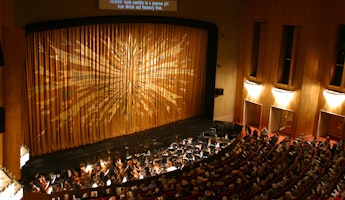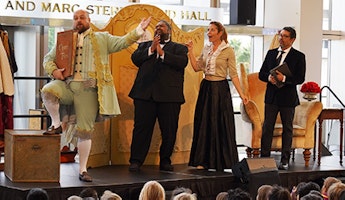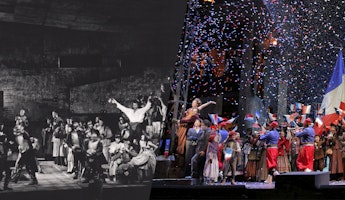Blog
February 7, 2024
The Real Life Couple Behind "Highway 1, USA"
It’s February, and love is in the air. Opera boasts some of the grandest romances ever put on stage, but there are occasionally some swoon-worthy stories behind the curtain as well.
While you certainly know Mimì and Rodolfo or Alfredo and Violetta, we’re willing to bet you’ve never thought of the real-life romance behind Highway 1, USA. This powerful opera about a couple’s trials and tribulations as they dream of a better life was put together by the husband-and-wife duo of composer William Grant Still and librettist Verna Arvey. The two of them faced unending struggles as an interracial couple in a segregated America—the former being a Black man and the latter a woman of Russian-Jewish heritage—and their story is one that deserves to be told.
Still and Arvey were introduced in 1930 when Still traveled from New York to Los Angeles to meet with fellow composer Harold Bruce Forsythe. Arvey, an LA native, was a concert pianist and a longtime friend of Forsythe, who gave her some of Still’s music to read. Forsythe eventually brought the two together, and they grew gradually more acquainted during Still’s time in LA.
Though sparks may have flown, a relationship was not on the table at the time. Still was married to Grace Bundy, and the couple had four children. But the two were reaching the end of their relationship, and they officially separated in 1932, with Bundy taking custody of the children. After Still moved to Los Angeles in 1934, he and Arvey got back in touch, and in 1937 he even asked her to help finish penning his opera, Troubled Island, after the original librettist, poet Langston Hughes, left to cover the Spanish Civil War for The Baltimore Afro-American. The opera was completed in 1939, and that same February, Still finalized his divorce from Bundy and married Arvey just two days later.
It wasn’t a conventional wedding by any means: to get around the laws banning interracial marriage in California, the couple drove across the border to Tijuana. To commemorate his new love, Still dedicated his next composition to Arvey, a symphonic poem for piano and orchestra entitled Kaintuck’. It was first performed in 1935 by the Los Angeles Philharmonic under the baton of conductor Otto Klemperer—with Arvey herself as the soloist.
Not to be outdone in terms of grand romantic gestures, Arvey became one of Still’s greatest champions. She wrote the librettos for three more of her husband’s operas: A Bayou Legend, Costaso, and Highway 1, USA. In 1939, she published Studies of Contemporary American Composers: William Grant Still which offered an in-depth look at all of Still’s compositions.
Still and Arvey remained creative partners, and by all accounts were loving parents and a happy couple until Still’s death in 1978. Their home in Oxford Square was designated a Los Angeles Historic-Cultural Monument in 1976, and Arvey continued her efforts to promote Still’s musical legacy with a 1984 biography, In One Lifetime. Arvey would pass away in 1987 leaving Still’s legacy to be shared and protected by their daughter, Judith Anne Still.
William Grant Still and Verna Arvey were certainly a power couple, even defying laws designed to keep them apart. Keep your eyes and ears open during our upcoming production of Highway 1, USA and you’ll even find echoes of their triumphant love story woven into the poignant libretto and jazz-influenced score.








/03-cosi/_dsc0996_pr.jpg?format=auto&fit=crop&w=345&h=200&auto=format)
















